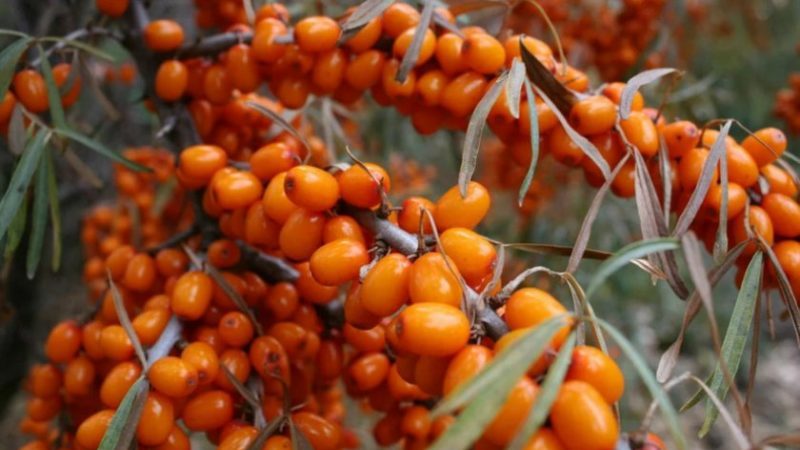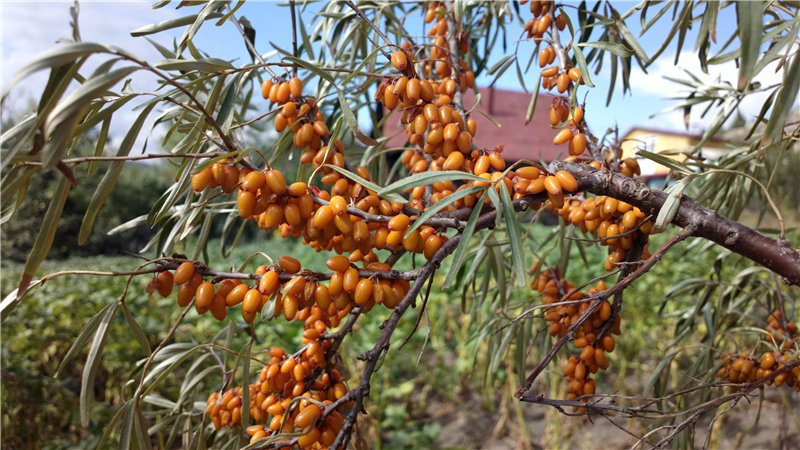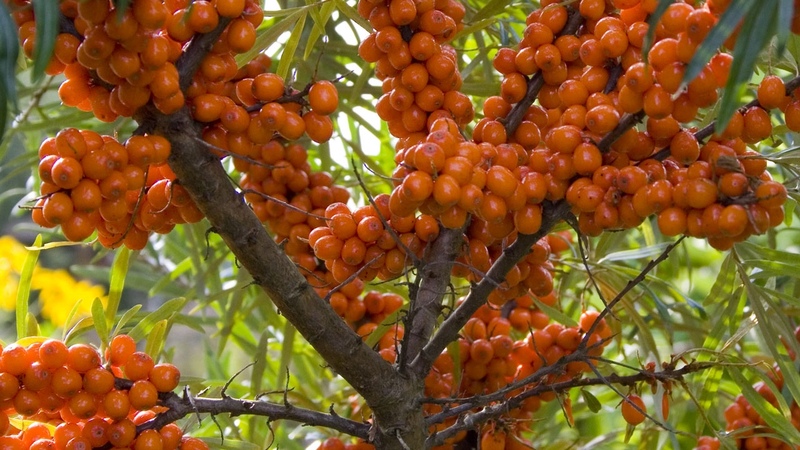Variety of thornless sea buckthorn varieties
Sea buckthorn is an indispensable ingredient for the preparation of winter supplies and a rich source of vitamins, minerals, fatty acids. Shrubs are unpretentious in care, show stable and high productivity in all parts of Russia. However, some varieties have a significant disadvantage - thorns on the branches, which make it difficult to harvest and scratch your hands. Therefore, many gardeners choose seedlings of thornless varieties.
The content of the article
Large varieties of sea buckthorn without thorns

Sea buckthorn, unpretentious in care, is rich in vitamins and is appreciated in folk medicine and cooking. Large varieties differ in the taste of berries, grow in the Urals and Siberia, the Moscow region and the Central region. The culture is winter-hardy, bears fruit stably.
Openwork
The early ripe variety is recommended for cultivation in the West Siberian and East Siberian regions. Sprawling bushes, no thorns. The berries are cylindrical, the weight of one is about 1.5 g. The color is bright orange-yellow, the peel is of medium density. Sour taste, tasting score - 4.9 points out of 5. The variety is resistant to frost, drought, heat, fungal and viral diseases.
During flowering, the tree looks beautiful on the site. In care, sea buckthorn Openwork is simple, does not require frequent trimming... The yield reaches 64 kg / ha.
Essel
An early medium versatile variety for cultivation in Siberia. Winter, drought and heat resistance are average. The plant is resistant to sea buckthorn fly.
The shrub is weak, the crown is round, compact. The spines are short, there are few of them on the branches. Berry weight - about 1.2 g, egg-shaped, yellow-orange color. The taste is sweet, the score is 4.7 points.
Essel is appreciated for its attractive commercial qualities, tart sweet taste of berries and keeping quality. The harvest ripens in August. Gardeners do not allow overripening, as sea buckthorn does not adhere well to the branches and crumbles.
Giant
Sea buckthorn Giant is planted in the Volgo-Vyatka, Middle Volga, Ural, West Siberian, East Siberian and Far Eastern regions.
Bushes of late ripening, medium density, round crown. Shoots are light brown, leaves are dark green curved. Fruits are cylindrical in shape, weight - from 1 to 1.5 g. Glossy orange peel. The average yield of the variety is 88 c / ha. The culture is frost-resistant, susceptible to attacks by ticks and sea buckthorn flies.
To obtain a rich harvest, it is recommended to treat the bushes with a solution of urea or Bordeaux liquid. The preparations protect sea buckthorn from ticks and flies.
Friend
The bushes are medium-sized, the crown is slightly spreading, the shoots are straight and thin. Sea buckthorn is not prickly. Leaves are light green, shiny. Fruits are oval, weight - about 1 g. The color is rich orange, the peel is glossy, the taste is sweet and sour. Assessment - 4.2 points. The berries are used fresh and for processing.
The Podruga variety is frost-hardy - it can withstand temperatures down to -40 ° C. Resistant to endomycosis and sea buckthorn fly.
Attention! Water the culture in moderation, since it does not tolerate an excess of moisture. A young plant requires 30–40 liters of water, for an adult - about 70 liters. For watering, dig a hole near the trunk circle. If it is a rainy summer, the soil is regularly loosened so that moisture does not stagnate on the surface of the earth and does not evaporate.
The recommended growing region is West Siberian.The yield reaches 93 kg / ha.
Winter-hardy varieties without thorns for the Moscow region

Sea buckthorn near Moscow pleases gardeners with a rich harvest and juicy pulp. It is recommended to choose plants with strong immunity. Sea buckthorn is harvested in July or August (depending on soil conditions and weather conditions). Consider the popular varieties of sea buckthorn without thorns for the Moscow region and Moscow.
Moscow beauty
The bush is small, the crown is compact. Fruit weight - about 0.8 g, rich orange color, oval-rounded shape. Dessert juicy taste with rich sea buckthorn aroma. Assessment of tasters - 4.5 points.
The variety is winter-hardy, not affected by diseases and pests. The Moscow beauty gives about 15 kg of berries from a bush over the summer. They are used fresh or for processing - they make tasty and healthy jam.
Botanical amateur
An early ripe thornless variety is grown in the Moscow region, the middle lane, and the Leningrad region. Plant height - about 4 m, dense pyramidal crown. The fruits are oval-shaped, orange-yellow. The skin is glossy and thin, the stalk is long. The berry mass is about 0.9 g, the yield is up to 20 kg per tree over the summer.
The fruits are poorly stored, so they are eaten fresh or sent immediately for processing. The variety is resistant to pests and diseases, low winter temperatures.
Moscow pineapple
The name Moskovskaya Pineapple got its name from the aromatic and juicy pulp - the fruits grow sweet, with a pleasant taste. The weight of the berry is about 0.6 g, the height of the bush is up to 3 m, the shoots are curved and long. The shape of the berries is pear-shaped, elongated, the rind is thick. One bush gives up to 14 kg of fruit per summer, the harvest is notable for keeping quality and transportability.
The variety is winter-hardy, suitable for industrial cultivation, slightly affected by diseases and pests. In application, Moscow pineapple is universal.
Excellent
The late summer universal variety is suitable for growing in the Central, North, North-West, Volgo-Vyatka, Middle Volga, Ural, East and West Siberian regions.
The height of the tree is about 3 m, the foliage is dense, the crown is round, there are no thorns. Fruits are oval, weight - about 0.7 g. Color is bright orange, skin is smooth. Productivity - about 10 kg per tree. Sea buckthorn is suitable for all types of processing. Excellent frost-resistant, but attacked by pests.
It is interesting:
What can you plant honeysuckle next to and why is it important
Reliable and suitable for cultivation in harsh climates, the Leningradskaya black cherry variety
The most productive thornless varieties

The productivity of sea buckthorn is influenced not only by weather conditions, but also by the correct choice of varieties, soil nutrition, protection from diseases, rodents and pests. Harvest varieties are grown for personal consumption and sale. They are found in small garden plots and on farms.
Chuiskaya
The yield of the Chuiskaya variety is from 10 to 17 kg per bush, in a favorable summer it reaches 23 kg. The plant is medium-sized, the crown is compact, round. Shoots are dark green, leaves are curved. The shape of the berry is cylindrical-oval, weight is about 1 g. The color is yellow-orange, saturated. The pulp is sweet and sour with a tart aftertaste.
Chuiskaya is drought and frost-resistant, therefore it is suitable for growing in any regions of Russia. To protect against pests, it is recommended to carry out preventive measures: weed and mulch the beds, apply mineral fertilizing.
Gift to the garden
The average crop yield is 20 kg per bush. A mid-season variety is planted in the Volgo-Vyatka, Central, North-West regions.
The tree is medium-sized with straight and thick shoots. Leaves are large, dark green. The average weight of the berry is 0.6 g, the shape is oval-elongated, the skin is dark orange and dense, so the crop is stored for a long time and is suitable for transportation. The taste is sour, the pulp is pleasant, tart. The variety is rarely sick, frost-resistant.
Pearl oily
Fast-growing variety - the first harvest is harvested for 3 years after landing. One bush gives up to 15 kg of berries per season. Plant height - 2–2.5 m, oval crown, thorns are very rare. Leaves are green medium in size. Berries are oval-rounded, bright orange with a long stalk. Sea buckthorn weight - about 0.6 g. Sweet taste with a bright aroma. Tasting score - 4.7 points.
Pearl mussel does not crumble after ripening; during harvesting, the berries are easily separated from the bush. The culture is winter-hardy, tolerates drought and heat. Recommended for planting in the middle lane and the West Siberian region.
Jam
It is a mid-season and versatile variety. Sprawling bushes with an oval crown and dark green leaves. Berries are oval, average weight - 1 g, orange color with a reddish tint. The pulp is sweet and sour. Dzhemova's yield is up to 17 kg per plant per season.
The variety is drought-resistant and winter-hardy. Thanks to their dense skin, the berries are stored after harvest and are suitable for long-distance transportation and sale.
Interesting! Sea buckthorn has a high oil content (10.2%). It is used in cooking, cosmetology, medicine. The substance has anti-inflammatory and antibacterial effects.
The culture is zoned for the West and East Siberian regions.
Shrub not prickly sea buckthorn
Such sea buckthorn will decorate any summer cottage - small bushes look neat and attractive. Gardeners plant them along the fence or in the corners of the site. Suitable for growing darkened places where little sunlight penetrates.

Elizabeth
Bushes are undersized with a compact crown. In care, sea buckthorn takes little time - frequent pruning of shoots and crown formation are not required. Elizabeth ripens at the end of the summer season. The variety is resistant to pests and diseases. Suitable for growing in the Urals and Siberia.
Fruit weight - up to 1 g, cylindrical shape. The taste is sweet and sour, juicy and spicy. The berries grow on long stalks, so they are easily separated from the branch. The color is orange, it stands out noticeably on the site. The fruits are added to pies and cakes, fruit drinks are made from them, and eaten fresh.
Baikal ruby
The height of the bush is up to 1 m, the crown is compact. The Baikal ruby is unpretentious and grows in the coldest regions. Ripens in the second half of August.
Berry weight - about 0.5 g. Oblong shape, orange-coral color. The pulp is dense, the taste is sweet and sour. Gardeners note high immunity - the culture does not get sick and is not damaged by pests. The yield is stable - up to 12 kg per plant over the summer.
Sayan
The mid-early Sayan sea buckthorn variety begins to bear fruit 3 years after planting. Recommended for growing in Eastern Siberia. Beautiful and compact bushes look harmoniously on the site. Fruits are resistant to cracking, the variety does not suffer from fusarium.
Berries are oval, bright orange with a red bloom. The taste is sweet and sour, the aroma is moderate. The skin is dense, the sea buckthorn comes off simply, the thorns are few. The yield reaches 11-16 kg per season from one bush. The use of fruits is universal.
Perchik
Spines on the bushes of the Perchik variety are found, but very rarely. The plant is compact, in the shape of an umbrella. Fruit weight - up to 0.7 g, dense pulp, dry separation. Ovate, orange color, glossy skin.
Productivity - about 7 kg per bush per season. Perchik ripens in late July - early August, depending on weather conditions. Suitable for growing in the Central, Volgo-Vyatka regions.
Sea buckthorn varieties without overgrowth

Shoots are young shoots unnecessary for the plant. They slow down the development of bushes, reduce yields and cause disease. There are especially many sprouts in old gardens, where, in addition to sea buckthorn, cherries, raspberries, currants and other berries grow. Removing such shoots takes time and effort. To avoid unnecessary worries, gardeners choose sea buckthorn varieties without thorns and growths.
Chechek
Medium-sized, neat bushes also have a decorative function. The crown is spreading, there are no thorns. The fruits are broadly oval, the weight of one is from 0.8 to 1 g. The pulp is sweet and sour with a high oil content (7.8%). The color is orange with a reddish blush at the calyx and base of the peduncle. Average yield - 168.5 c / ha.
Chechek ripens in the first half of September. The variety is frost-hardy and unpretentious, therefore it is suitable for growing in Eastern Siberia and the Far East. To increase the yield, the plants are sprayed from the sea buckthorn fly.
Amber necklace
Bushes of medium height, round, semi-spreading crown. Shoots are straight and thick, leaves are large. Berry weight - 1–1.5 g, taste sweet and sour, tart. The yield of the Amber Necklace is up to 14 kg per bush, the first fruits are harvested in early September.
Of the advantages, resistance to diseases, pests and frost resistance are distinguished. The variety is recommended for planting in the Ural region.
Druzhina
An early ripe universal variety for the Urals and Siberia. The bushes are weak, the crown is compressed. Shoots are medium brown with a gray bloom. Fruit weight - up to 0.7 g, the skin is smooth and shiny. The taste is sweet and sour, the pulp with a high content of vitamin C (167 mg%).
Harvest is used for freezing, processing and cooking. In care, the variety does not require special measures, it needs timely watering and fertilization.
Star Trek
The trees are tall with a spreading and dense crown. There are very few thorns - they harvest without difficulty. Berry weight - about 1 g, oblong shape, red-orange color. The skin is of medium thickness, so the fruit is used for transportation. The taste is sweet and sour with a refreshing sea buckthorn aroma.
Star Trek is winter-hardy and heat-resistant, universal in application. Suitable for growing in Western Siberia.
Conclusion
Fans of large sea buckthorn without thorns choose Essel or Giant for planting: the berry weighs 1–1.5 g, the taste is pleasant, the harvest is stored for a long time. The varieties Moscow Beauty and Botanicheskaya Favorite are suitable for growing in the Moscow region: the plants are frost-resistant, rarely get sick, the fruits are universal in use. For those who prefer not only tasty berries, but also neat bushes, there are the Elizaveta and Baikal Ruby varieties.
When choosing, they pay attention to the appearance of the seedling, the ripening period of the variety, yield indicators, immunity to diseases and pests.